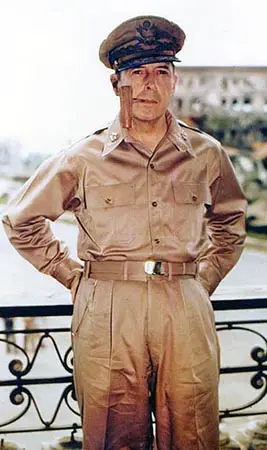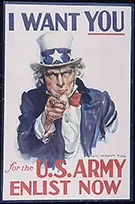Douglas MacArthur
Douglas MacArthur spent his life in the army. He was born on a military base and he died in a military hospital. In the years in between, he led American troops in retaking the Philippines after the Japanese took the island.


Early Years
Douglas MacArthur was born on January 26, 1880 in Little Rock, Arkansas. He was born on an army base and he spent his entire life in the army. He came from a family with a strong military background and moved from army post to army post.
He attended the West Texas Military Academy and once he graduated, he was accepted at West Point Military Academy. He graduated top of the class from West Point in 1903

Early Military Career
After MacArthur graduated from West Point, his first assignment was in the Philippines working with the Army Corps of Engineers. While in the Philippines, he was confronted with two armed men which MacArthur shot and killed.
MacArthur was promoted to first lieutenant while in the Philippines. After his assignment in the Philippines, he was assigned to work with his father touring through Asia inspecting the military forces of various countries in Asia.
After working with his father, MacArthur was ordered back to Washington where he enrolled in Engineer School in September 1906. He also worked as an aide to President Roosevelt. He stayed in Washington until August 1907 before being sent to various places throughout

Veracruz
In 1914, President Wilson sent American forces to occupy Veracruz. MacArthur became a member of the headquarters staff on May 1, 1914. MacArthur noticed that the army lacked the needed locomotives to support an advance from Veracruz. There were a number of railcars in Veracruz but no locomotives to move them.
MacArthur hired a handcar and used it to get to Alvarado where he found locomotives. He also found people to run the locomotives. MacArthur and his party were attacked a number of times on the way back to Veracruz and although he wasn’t wounded, MacArthur’s clothes were full of bullet holes by the time they made it back to Veracruz.
A recommendation for MacArthur to receive the Medal of Honor for his actions was made but it was turned down because MacArthur did not have orders from his commanding officer before leaving for Alvarado. Even though his commanding officer supported giving MacArthur the Medal of Honor, the awards committee was concerned that if they gave MacArthur the medal, it would encourage other officers to take action without their commanders’ knowledge.

World War I
When the United States entered World War I, MacArthur was put in command of the 42nd Division after being promoted to colonel. This was a division made up of men from different states and was called the Rainbow Division. He was involved in a number of major offensives (St. Mihiel, Meuse-Argonne, and Sedan offensives) during the war and distinguished himself a number of times.
Over the course of World War I, MacArthur was cited for bravery seven times and received thirteen medals. MacArthur received more decorations than any other American soldier in the war.

After World War I
After the war, MacArthur was assigned to be the commander of West Point. He was the youngest commander to hold that post and over the course of the next three years, he modernized the curriculum to better reflect new methods of warfare and doubled the size of West Point.
MacArthur was married in 1922 but the marriage was not a happy one. His wife often made remarks intended to humiliate MacArthur and the marriage was ended in 1927 when the couple separated. They later divorced in 1928.
MacArthur was made chief of staff in 1930 and promoted to general. As the chief of staff, his job was to protect the military which was facing pressure from the Great Depression. In addition, he frequently warned the government about the increasing threat from communism.
Up to now, MacArthur was very popular but his reputation was damaged when he was ordered to disperse a number of demonstrators who had gathered in Washington. The demonstrators were mainly World War I veterans who were demanding the early release of a bonus. When the demonstration turned violent, the army was sent in.
MacArthur decided to accompany the army when they went and the soldiers used tear gas to clear the area. This affected MacArthur’s popularity with the general public but it did increase his popularity with the right-wing members of the government.
In 1935, MacArthur was sent to the Philippines to help develop the Philippine army. While he was heading to Manilla, MacArthur met Jean Marie Faircloth. They fell in love and were married in 1937. MacArthur and Jean had a son the following year.

World War II
The Japanese attacked Pearl Harbor on December 7, 1941. This was followed by an attack on the Philippines on December 8. MacArthur’s forces were not prepared for the attack and they were quickly defeated.
President Roosevelt ordered MacArthur to retreat to Australia and leave his men behind. It was at this time that he uttered his famous words “I shall return”. MacArthur thought that there would be troops waiting to immediately attack and reclaim the Philippines but when he arrived in Australia, there were no troops waiting. Once in Australia, MacArthur was made the supreme commander of Allied forces in the southeast Pacific region.
MacArthur began his military operation by defending Port Moresby. Once he held off the Japanese attack on Port Moresby, he began a campaign of island hopping. His strategy was to attack small Japanese bases while putting larger ones under siege to starve them out and simply moving on. MacArthur also insisted that the army only advance as far as the air force could support.
This resulted in MacArthur’s campaign experiencing fairly low casualties. The march from Australia to the Philippines resulted in fewer casualties than Eisenhower’s single campaign at the Battle of the Bulge. The campaign took two and a half years before MacArthur returned to the Philippines in October 1944. Six months later, the Japanese were pushed out of the country.
MacArthur was promoted to General of the Army at the end of 1944 and in April 1945, he became the commander of all American army forces stationed in the Pacific. On September 2, 1945, MacArthur oversaw the official surrender of the Japanese on the U.S.S. Missouri. He was also placed in command of the occupation forces in Japan and over the next six years, he helped rebuild Japan and put into place reforms in an effort to make Japan more democratic.

Korean War
When the North Koreans invaded South Korea in 1950, MacArthur was put in command of the United Nations troops. MacArthur had a lot of initial success with a counterattack at Inchon. The United Nations forces were able to push the North Koreans back towards the Chinese border.
Truman was worried about the Chinese sending in forces as MacArthur’s forces approached the Chinese border but MacArthur told Truman that this was unlikely to happen. Unfortunately for MacArthur, he was wrong.
In late 1950, the Chinese sent in a large number of troops and pushed MacArthur’s forces back into South Korea. MacArthur wanted to extend the war into China. He requested that the air force bomb China as well as having Chinese Nationalists soldiers from Taiwan attack China.
President Truman refused this request but MacArthur attempted to publicly build support for the attack of China. Truman ended up relieving MacArthur of command in 1951 because of MacArthur’s strong support for an attack on China.
At first, the American public were upset with Truman over MacArthur’s dismissal but Truman insisted that the Korean War needed to remain on the Korean peninsula and not move into China.

Home
MacArthur returned home in April, 1951 and addressed Congress in an attempt to defend his position on the Korean War. When asked about the larger global implications of his position, he stated his focus was on Asia and not on the world as a whole. To some extent, this undermined MacArthur’s statement that he understood the Korean situation better than other military commanders because he could not give an effective response to the position that Truman and the Joint Chiefs of Staff had a better understanding of the world political situation.
Support for Truman’s position rose when the public came to realize that MacArthur’s strategy would have led to an expanded war in Asia.

Death
In 1952, MacArthur made an attempt to get his name on the presidential ballot but the candidacy went to Dwight D. Eisenhower instead. MacArthur gave up his political ambitions and moved to New York where he gave speeches and continued to give his opinion of Asian affairs when called upon.



